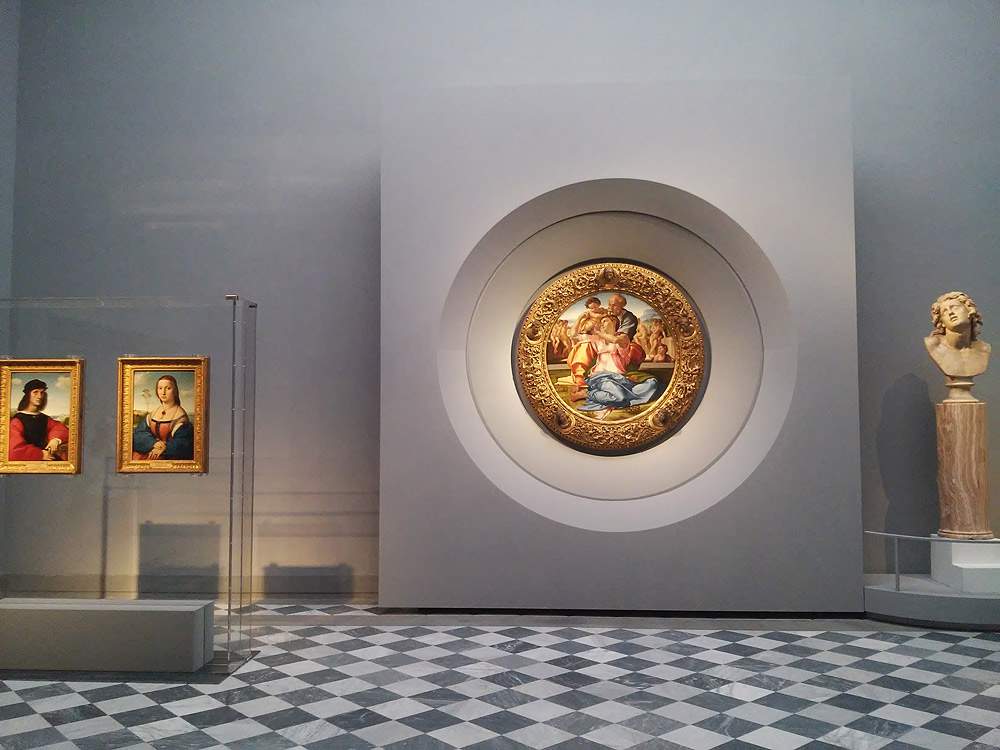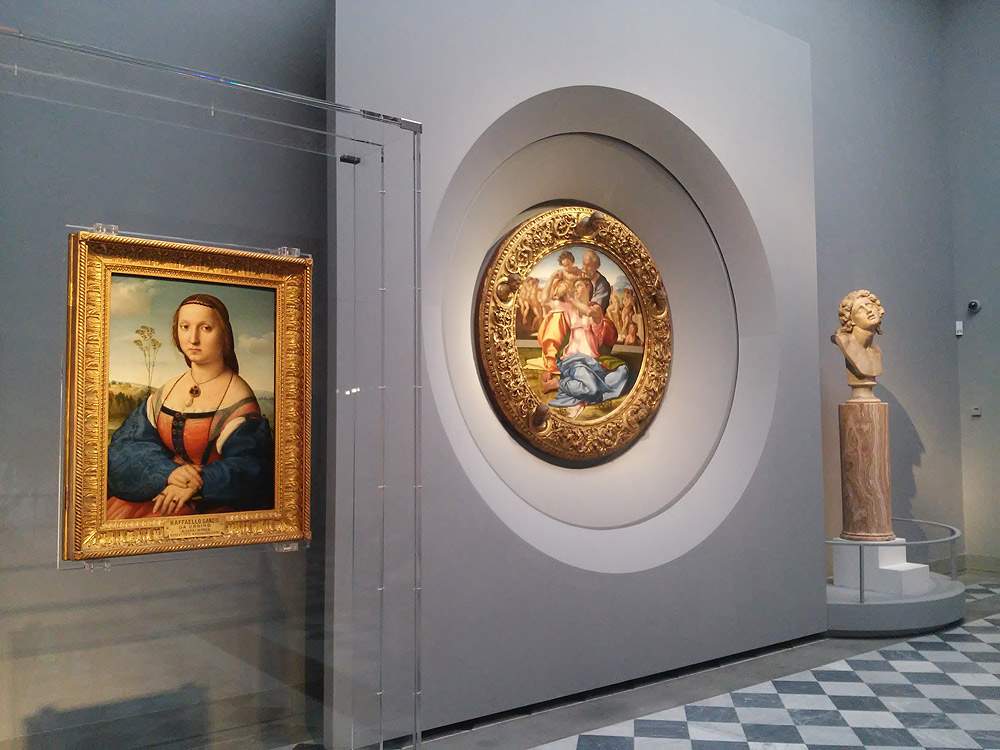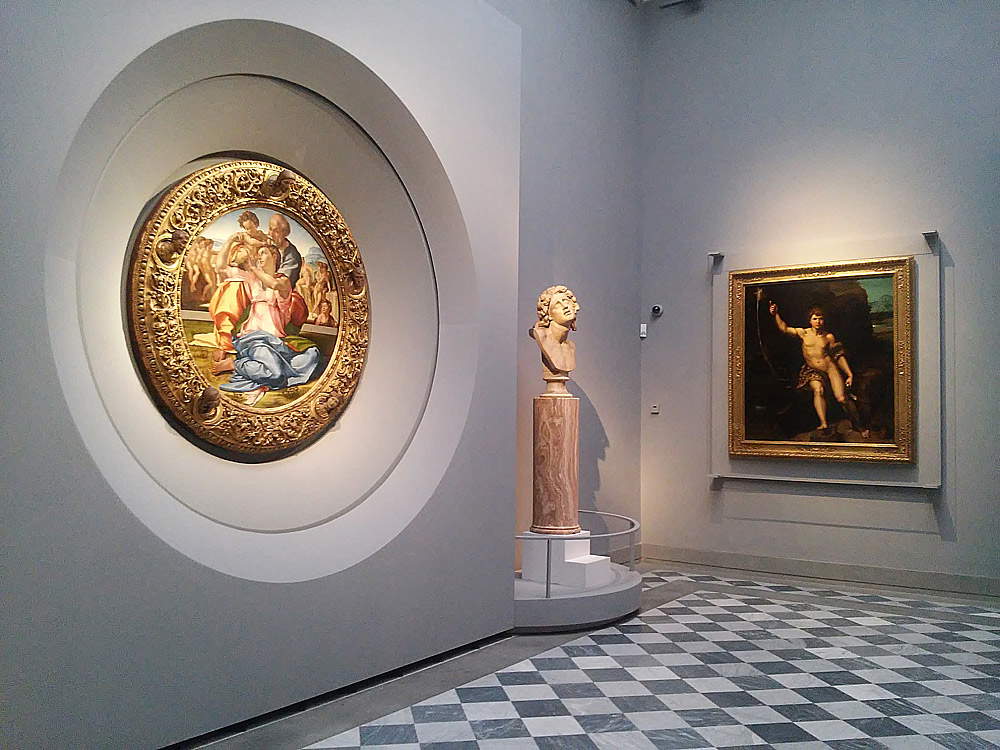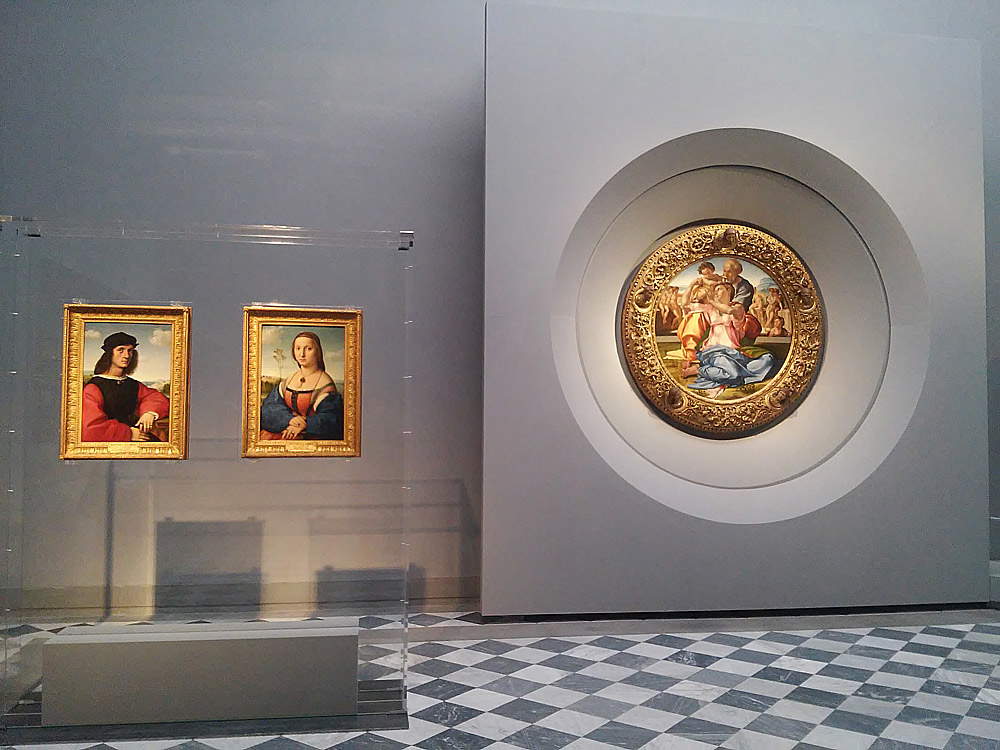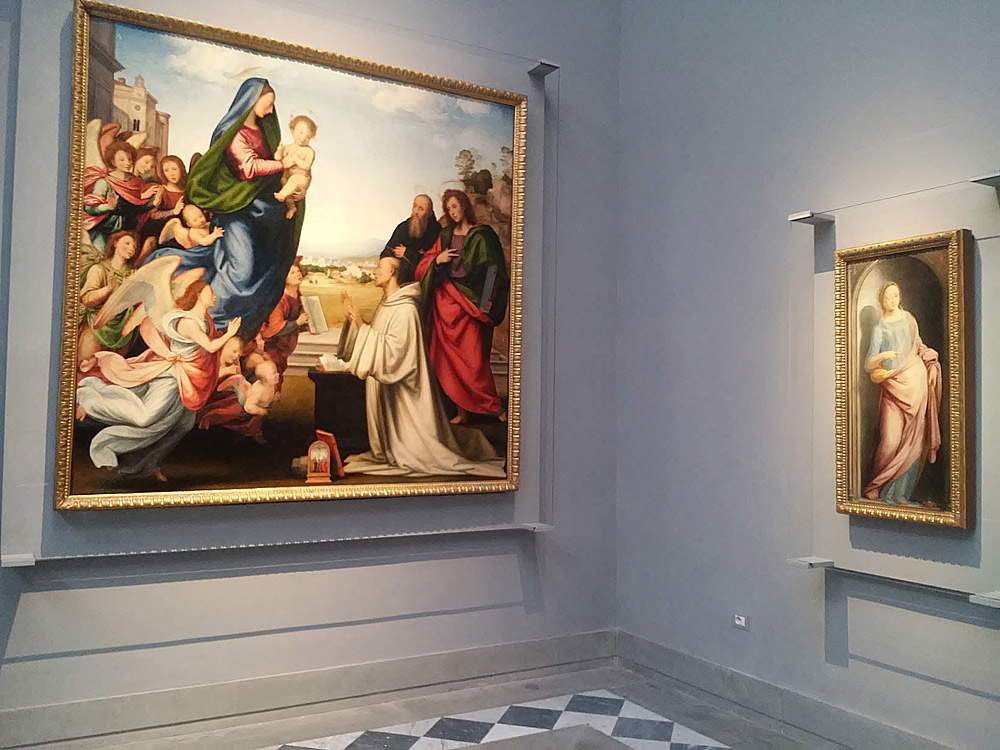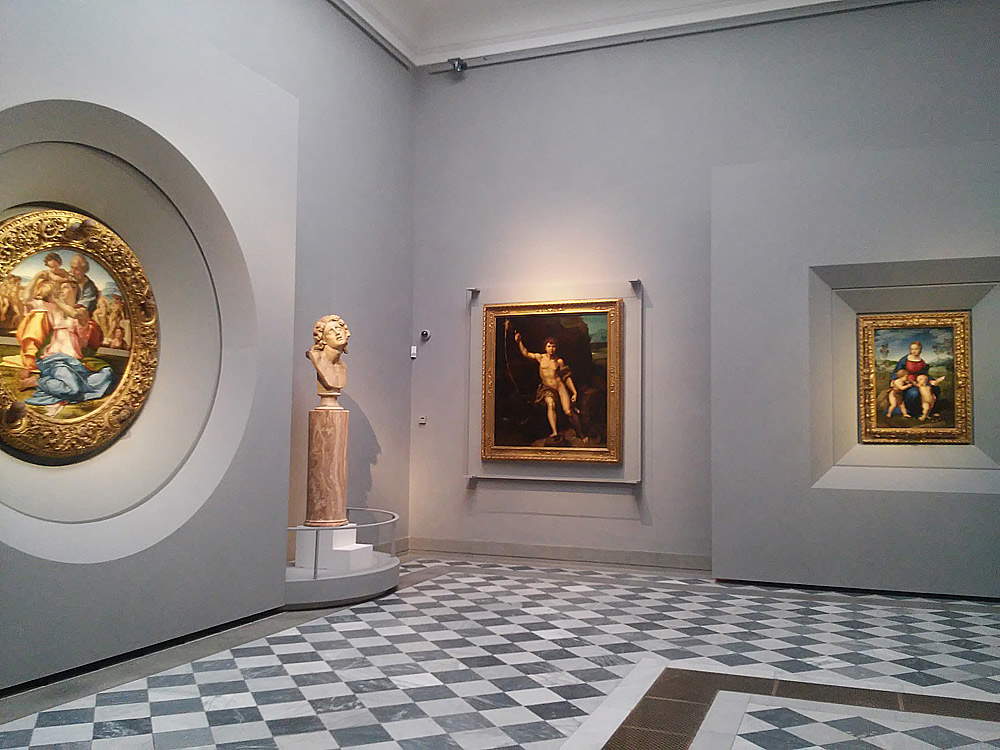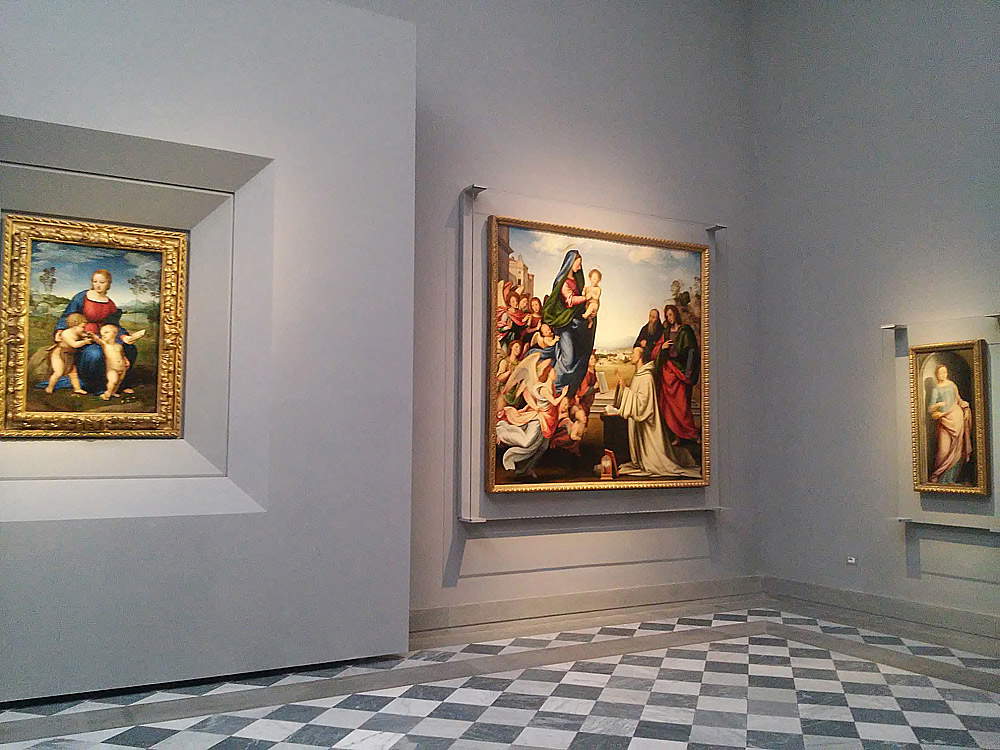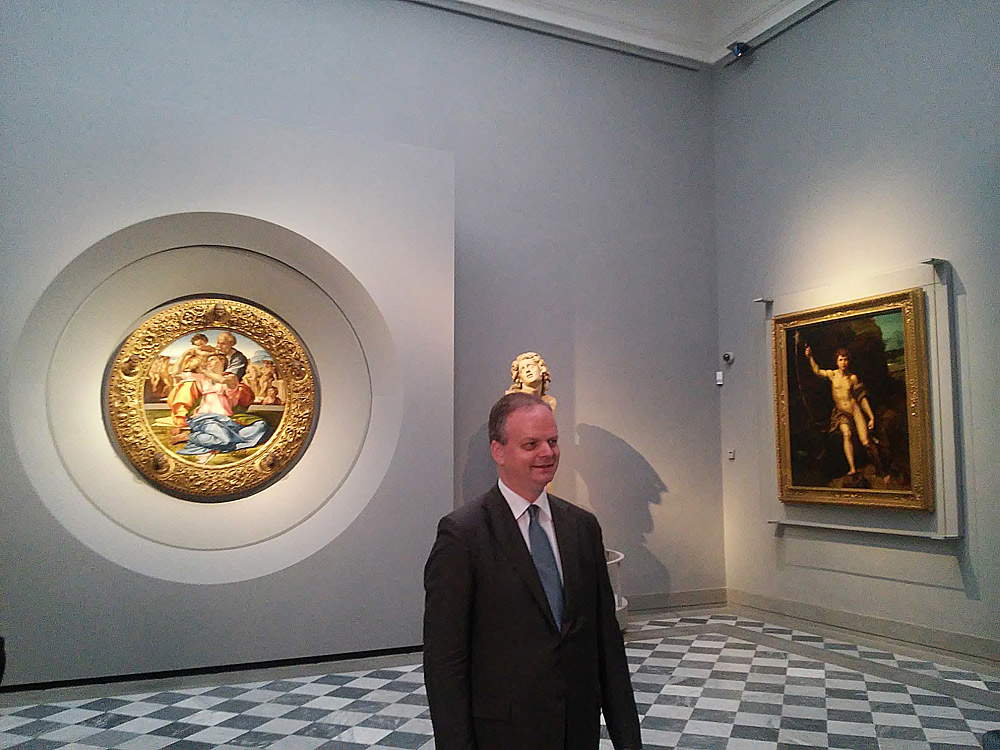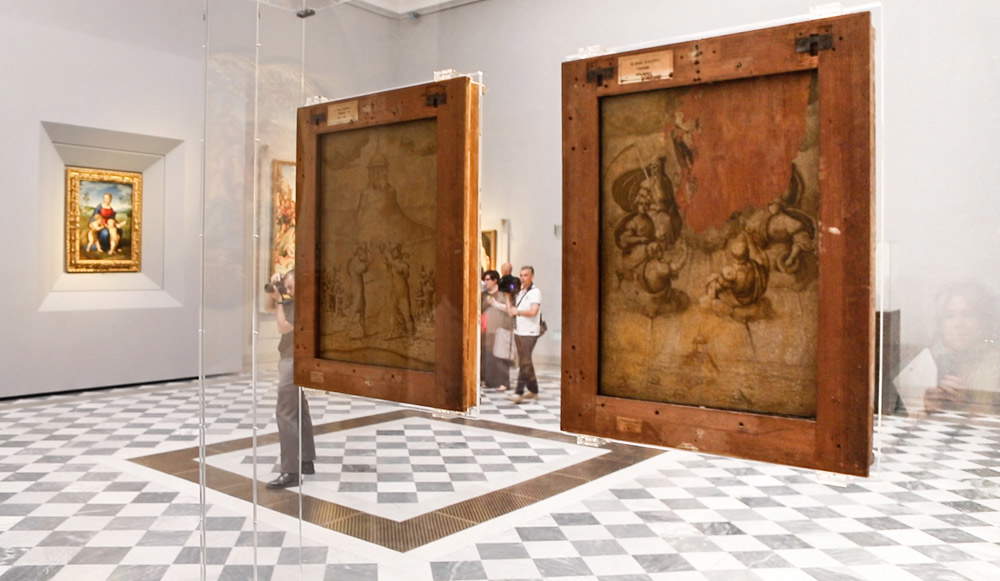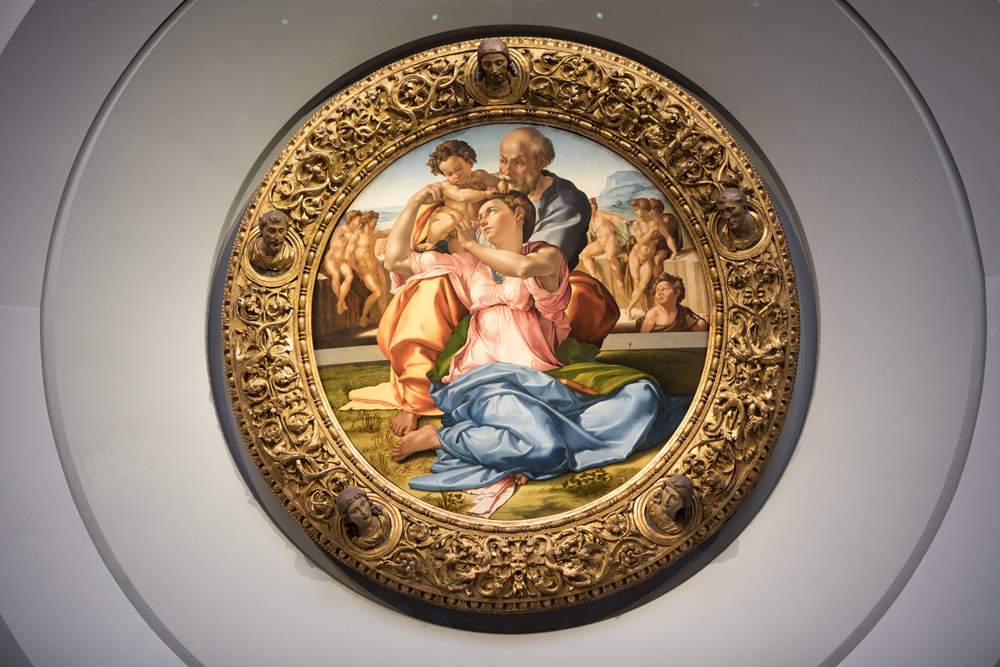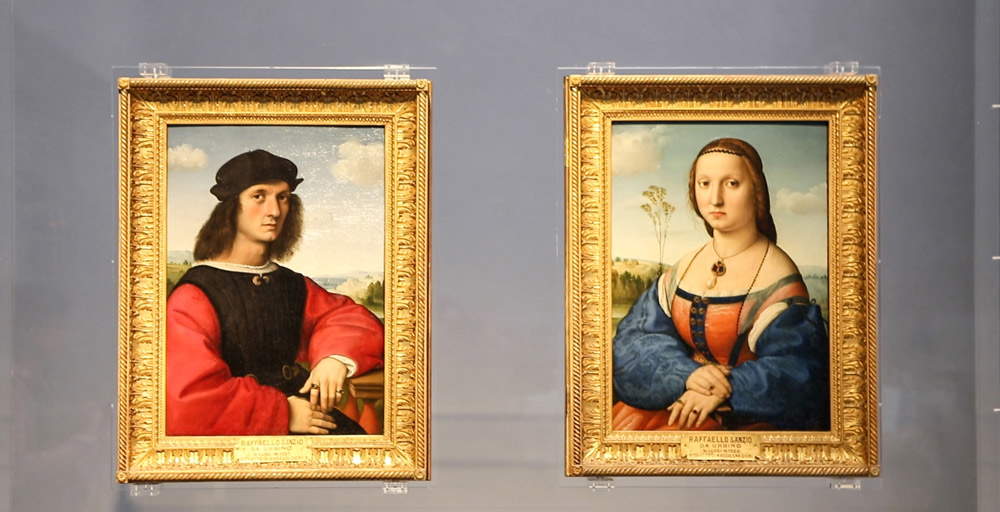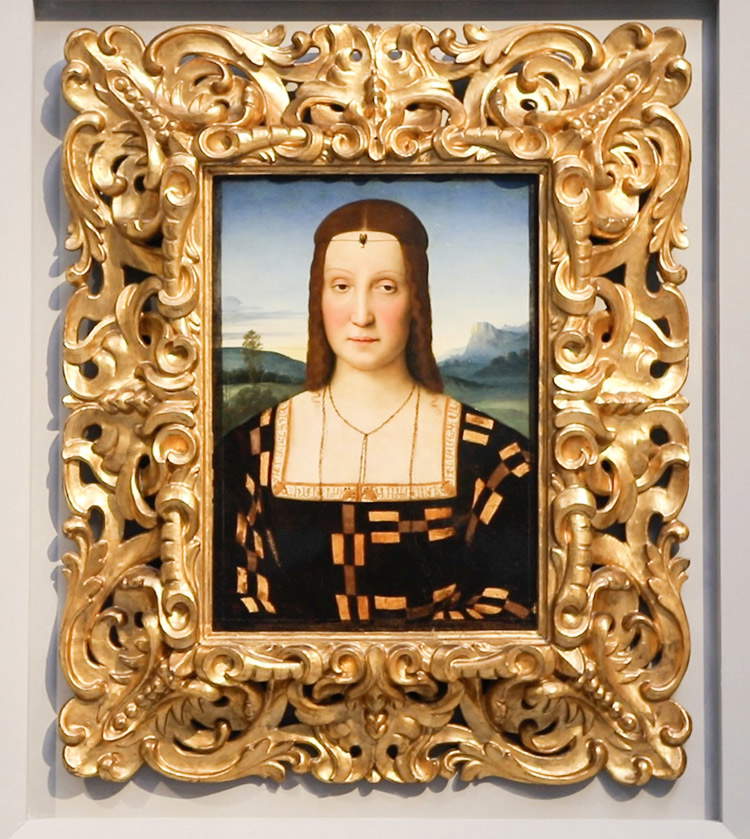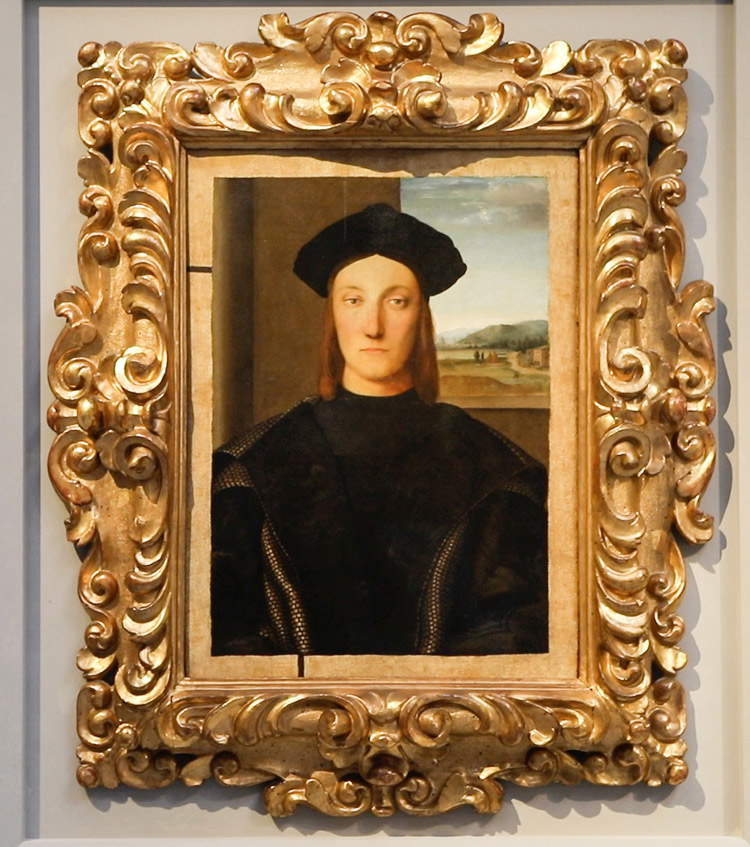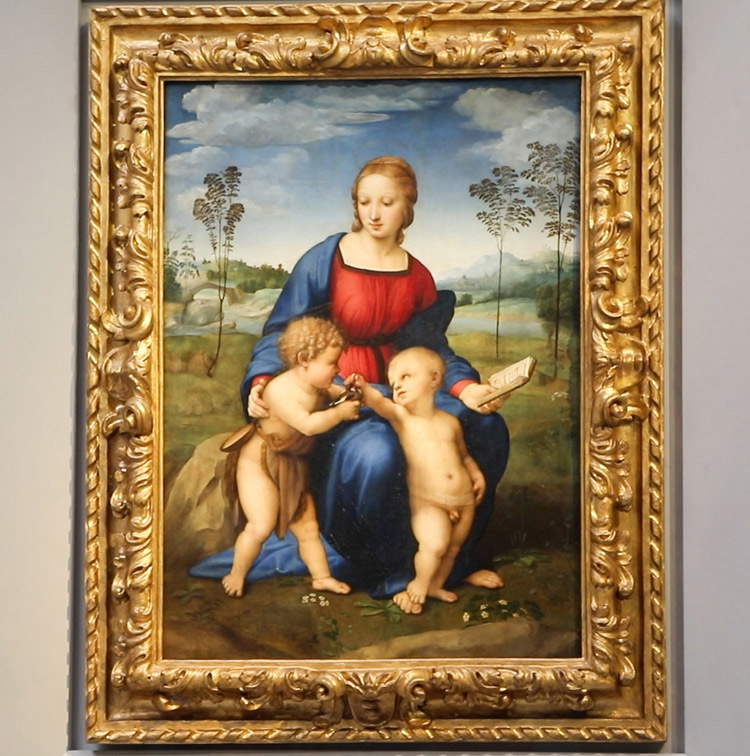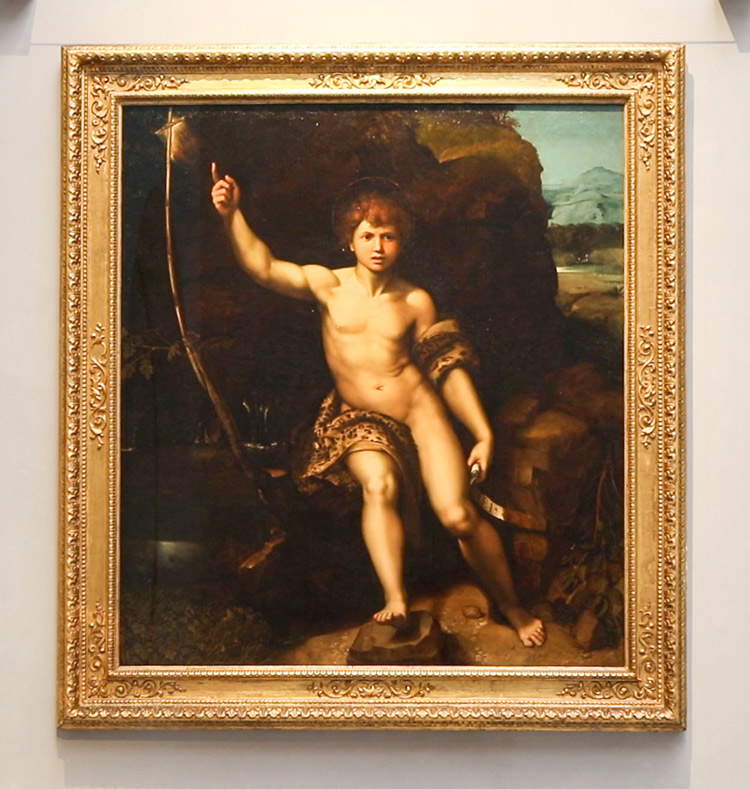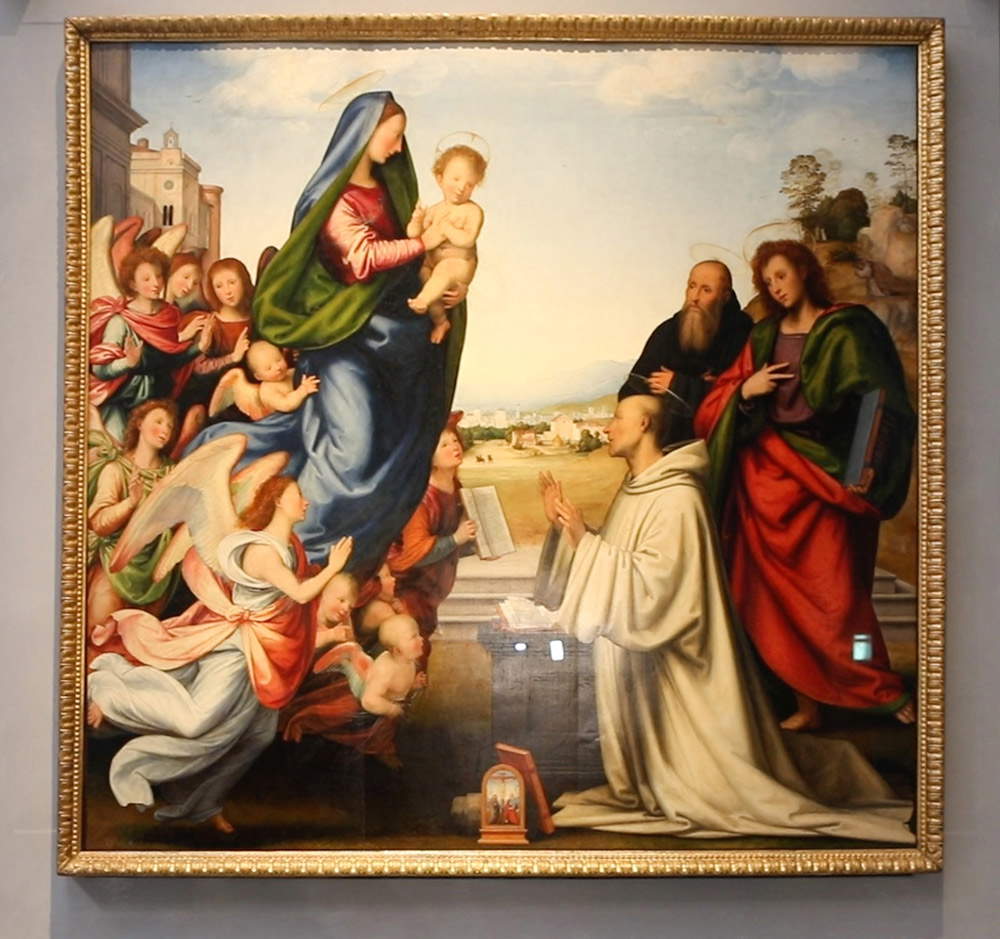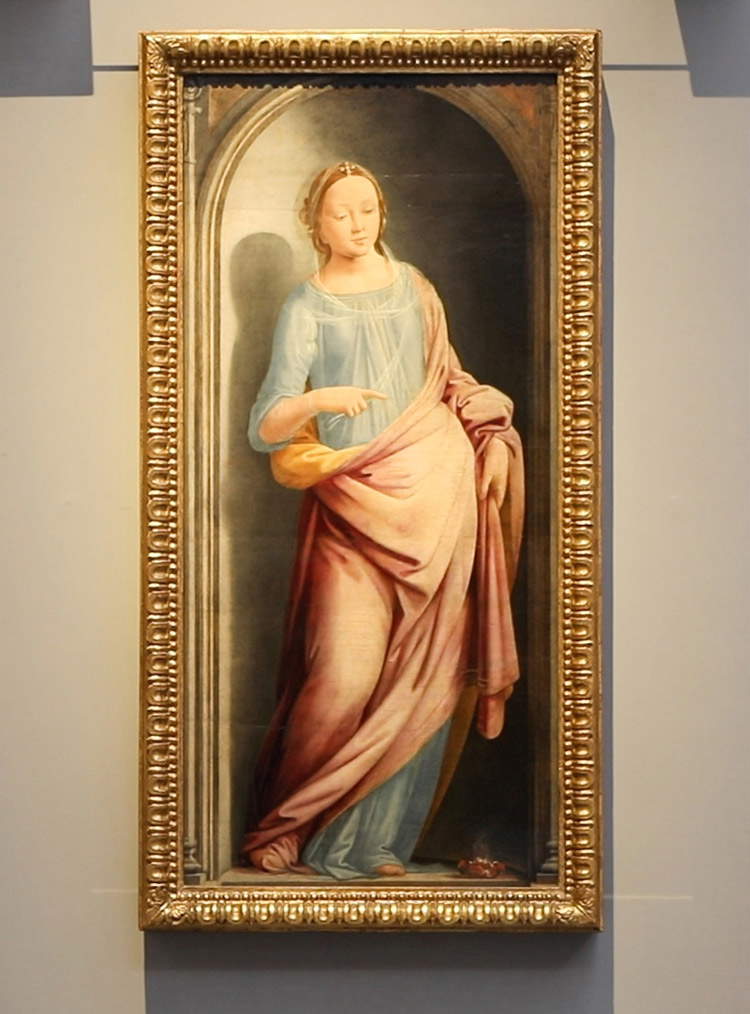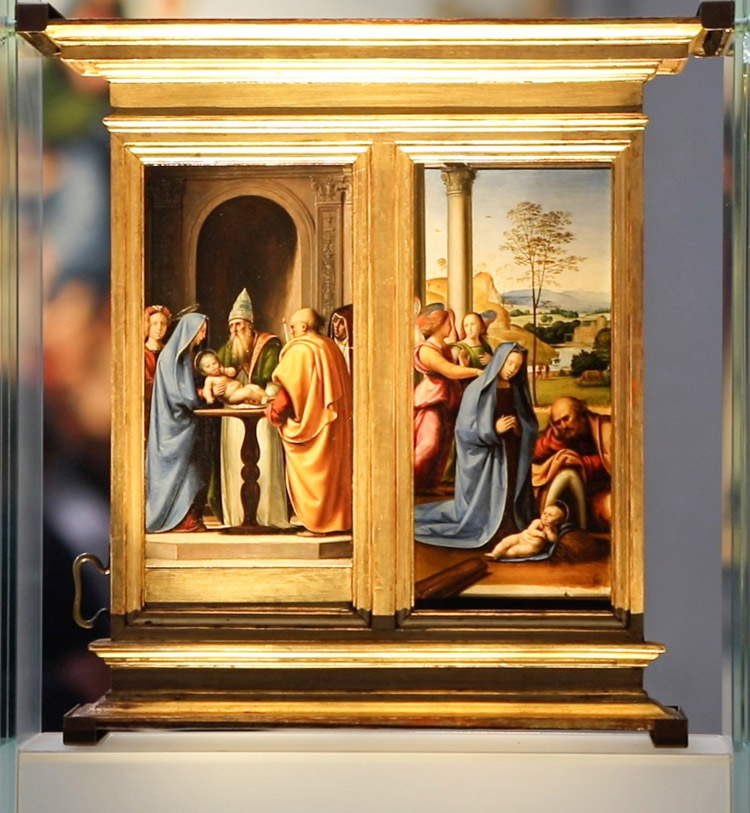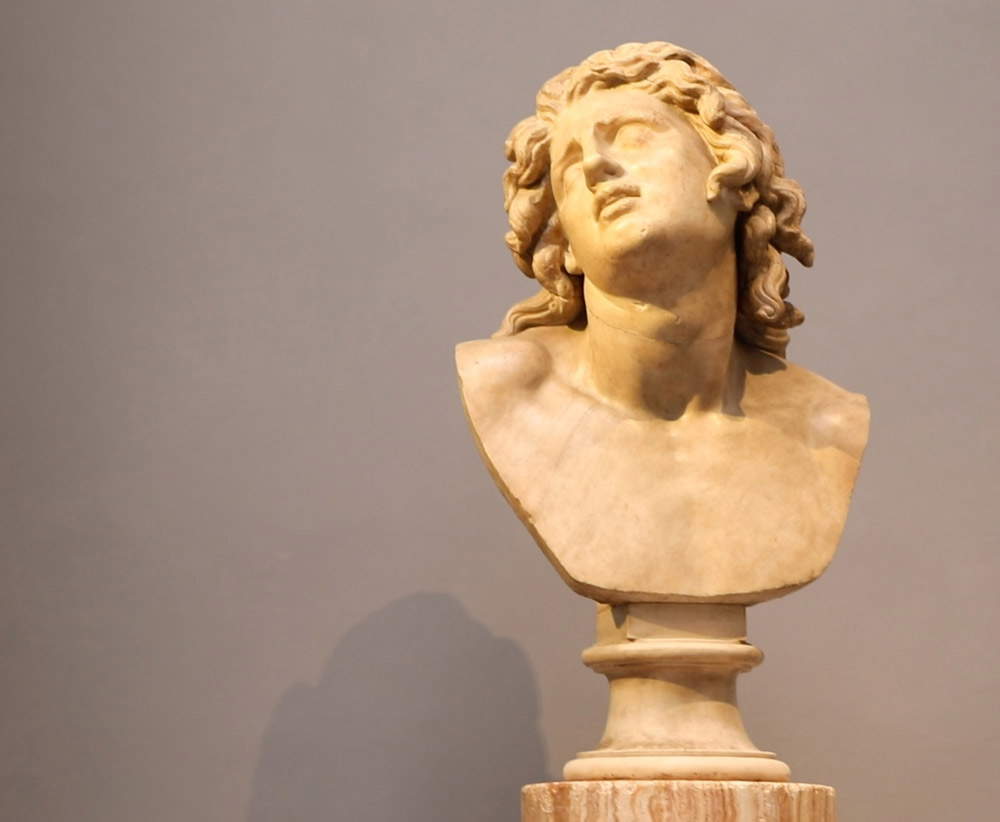by Redazione , published on 04/06/2018
Categories: News Focus
/ Disclaimer
New Room 41, housing works by Michelangelo, Raphael and Fra' Bartolomeo, opened at the Uffizi. Statements from the director and curator of the project, and exclusive preview photos.
A new room dedicated to Michelangelo and Raphael was unveiled today at the Uffizi Gallery in Florence. In the room, room 41 of the Ponente Corridor, some of the most important masterpieces of the museum and of the Renaissance have been arranged: in the center is the Tondo Doni by Michelangelo Buonarroti (Caprese, 1475 - Rome, 1564), and on either side are works by Raphael Sanzio (Urbino, 1483 - Rome, 1520): the portraits of Guidobaldo da Montefeltro and Elisabetta Gonzaga, the much-discussed San Giovannino (possibly a workshop work), the Madonna del Cardellino, and the portraits of the Doni couple, Agnolo and Maddalena Strozzi, which were moved to the Uffizi from Palazzo Pitti to be displayed alongside the Doni tondo, commissioned from Michelangelo by Agnolo Doni, probably on the very occasion of his marriage to Maddalena Strozzi. The room is completed by the so-called Dying Alexander, a sculpture from the Hellenistic period that makes explicit Michelangelo’s relationship with classical statuary, and by the works of Fra’ Bartolomeo (Florence, 1473 - 1517), a great artist of the mature Renaissance who looked as much to Michelangelo as to Raphael: in the room we find the Pugliese Tabernacle, Portia and the Vision of St. Bernard.
Architect Antonio Godoli, curator of the project, chose muted grays to accommodate the works (the museum management’s stated goal is to make the walls “come alive” and enhance the colors of the works), and placed the Doni Tondo and Madonna del Cardellino in two large projecting structures. These two works, architect Godoli pointed out, are set inside glass cases that allow them to be observed at close range. The climatic condition inside the showcases, controlled by instruments always connected with the staff, guarantees the best preservation conditions, and the metal structures of the displays have anti-seismic requirements: this display system designed by the Uffizi and already adopted for Botticelli, Leonardo and Caravaggio, has since been realized in other cases of contemporary museography. The intent is to bring together, in the same environment, works produced in one of the most vital periods of the mature Renaissance in Florence, that of the early sixteenth century, which saw, between 1504 and 1508, the simultaneous presence in the city of the three great artists who now share the room through eleven masterpieces of equal importance. The arrangement of the room was offered by the associations Amici degli Uffizi and Friends of the Uffizi Galleries, both entirely dedicated to supporting the activities of the Uffizi Gallery.
The new installation, stressed Uffizi Director Eike D. Schmidt, replaces the paratactic exhibition of isolated and fetishized masterpieces with the principle of dialogue between the works, the artists and their patrons, and invites viewers to discover and trace the artistic exchanges between the greats of the past. For this reason, a third personality enters the scene who, thanks to the confrontation with Raphael, regains his own solo voice: Friar Bartholomew, a Dominican of St. Mark’s and a close friend of Sanzio, with whom since the latter’s arrival in the city in 1504 an intense and richly consequential exchange was established, which the visitor will in fact now be able to retrace through the paintings on display. Regarding the juxtaposition of the Dying Alexander with the Doni tondo, Schmidt said at the press conference, “the theme in the old installation of the Michelangelo room that I liked best was the relationship between the Doni tondo and ancient sculpture. We have taken up this theme and articulated it in a different way than in the previous installation: in fact, we put next to the Doni tondo the head of a triton, interpreted during the Renaissance and Baroque as a dying Alexander. The possible reception of this ancient head, by Michelangelo, was a discovery of Antonio Natali, but he had not realized it in the museum’s itinerary. So, from this point of view, we were more ... Christmassy than Natali in this new exhibit.”
On the subject of moving the portraits of Agnolo and Maddalena Doni from the Pitti Palace, Schmidt instead stressed, again at the press conference, that it was an operation aimed at emphasizing the relationships between artists and patrons in 16th-century Florence. “The new room,” said the director, “also gives value to the patrons in the Florentine Republic of Pier Soderini, who competed among themselves as to who was able to wrest the most masterpieces from these great geniuses who were gathered in Florence. The Doni are now recontextualized and reunited with their tondo, for the first time in four hundred years.” However, the transfer from the Pitti Palace will be compensated for with the arrival of a group of important masterpieces by Raphael: “this new arrangement is continued at the Pitti Palace: we do not want to follow up on the policy of the last two hundred years, which consisted of taking from Pitti without reciprocating: on the contrary, we have sent other works of great importance to the Pitti Palace in order to then also enhance this museum, which by the way is already enhanced by our strategy. Yesterday, for the first time, we had more visitors for the free Sunday at Palazzo Pitti than at the Uffizi: it is a sign that this strategy is working. We have sent some masterpieces to the Pitti Palace, which has always been the place with the most works by Raphael in the world (eleven, to be precise): from tomorrow there will be twelve and from next year thirteen.” In fact, the Palatine Gallery this year will be enriched by three works arriving from the Uffizi: the Portrait of a Young Man with an Apple (possibly Francesco Maria della Rovere), which will document the portraiture of the artist’s last Urbino period by reinforcing the space dedicated to him in the Sala del Saturno, the portrait of Julius II, and the portrait of Leo X (it is, in this case, a return: the work was in fact in the Pitti Palace until the 1950s, when it left the Palatine Gallery to move to the Uffizi). Raphael’s works will all be destined for the Sala di Saturno, which will become a sort of “permanent exhibition” on Raphael.
The Friends of the Uffizi, represented by vice-president Emanuele Guerra, also spoke at the presentation of the new exhibit, recalling the achievements and confirming the association’s commitment: “Twenty-five years ago the Friends of the Uffizi Association was born, which would be followed within a few years by its sister association in the United States: it is a significant anniversary, one that brings back memories of the wound inflicted on the Uffizi, the City and the entire civil society, but which, with the opening of the room dedicated to Raphael and Michelangelo, represents the hope and the sign of a real ’renovatio humanitatis. Among the first works restored with the support of the Friends of the Uffizi was Ladorazione dei pastori by Gherardo delle Notti: the latest restoration supported is that of Leonardo’s Ladorazione dei Magi: even today, the association confirms its support for the Galleries and looks forward to future commitments, without interruption, thanks to the participation of all those who support it and who, even from overseas, intend to be protagonists of this experience. To all of them must go our gratitude and to all those, including the press, who will be able to be its spokespersons.”
Finally, introducing the press to the new exhibit was Antonio Paolucci, who gave a short lectio magistralis. "The primary task of a museum of ancient art is to be didactic, to make understandable, as effectively as possible, through an appropriate selection of works, the history of the figurative arts. The new editing of the Michelangelo room, commissioned by Eike D. Schmidt and realized by Antonio Godoli, fulfills the task in an exemplary manner. There, you will find yourself at the center of the compass rose, at the center of the unfolding of the figurative arts in Italy and Europe in the following centuries. There is Michelangelo, who, as Giorgio Vasari said, is like a lantern, like a lamp, destined to illuminate the artists to come. And then you will see Raphael, the Raphael of the Doni portraits, the Raphael of the Madonna del Cardellino, the Raphael of the Urbino portraits. Raphael’s legacy will then pass to Guido Reni, to Poussin, to David, to Ingres, to Canova, all the way to the Picasso of his classical period. In this room, you will be able to touch with your eyes the works of Michelangelo and Raphael, set into the walls. I can only express my gratitude for those who made all this happen."
The new layout of Room 41 of the Uffizi is already causing a lot of discussion, but it is a consequence that the management of the Galleries had already largely budgeted for: “everyone can judge whether the layout of the room works or does not work. The goal is to stimulate visitors to look, compare, contrast, and draw their own conclusions, just as artists in the sixteenth century era also looked, tried to learn, and to surpass other artists.” Decisive was precisely the role of Antonio Paolucci: “At first I was not sure,” concluded Eike D. Schmidt, “about bringing the portraits of the Doni couple to the Uffizi. So I heard Professor Paolucci, who said. ’go.’ And we went.”
Below is a list of exclusive images of the new arrangements and all the works included in the rearranged Room 41.
 |
| Uffizi, new arrangement of Room 41 with works by Michelangelo, Raphael and Fra’ Bartolomeo. Ph. Credit Finestre Sull’Arte |
 |
| Uffizi, new layout of Room 41 with the works of Michelangelo, Raphael and Fra’ Bartolomeo. Ph. Credit Finestre Sull’Arte |
 |
| Uffizi, new layout of Room 41 with the works of Michelangelo, Raphael and Fra’ Bartolomeo. Ph. Credit Finestre Sull’Arte |
 |
| Uffizi, new layout of Room 41 with the works of Michelangelo, Raphael and Fra’ Bartolomeo. Ph. Credit Finestre Sull’Arte |
 |
| Uffizi, new layout of Room 41 with the works of Michelangelo, Raphael and Fra’ Bartolomeo. Ph. Credit Finestre Sull’Arte |
 |
| Uffizi, new layout of Room 41 with the works of Michelangelo, Raphael and Fra’ Bartolomeo. Ph. Credit Finestre Sull’Arte |
 |
| Uffizi, new layout of Room 41 with the works of Michelangelo, Raphael and Fra’ Bartolomeo. Ph. Credit Finestre Sull’Arte |
 |
| Uffizi, new layout of Room 41 with the works of Michelangelo, Raphael and Fra’ Bartolomeo. Ph. Credit Finestre Sull’Arte |
 |
| Uffizi, new layout of Room 41 with the works of Michelangelo, Raphael and Fra’ Bartolomeo. Ph. Credit Finestre Sull’Arte |
 |
| Michelangelo, Tondo Doni (1505-1506; tempera grassa on panel, 120 cm diameter; Florence, Uffizi Gallery). Ph. Credit Finestre Sull’Arte |
 |
| Raphael, Portraits of the Doni couple, left Agnolo (c. 1506; oil on panel, 65 x 45 cm; Florence, Uffizi Gallery), right Maddalena Strozzi (c. 1506; oil on panel, 63 x 45 cm; Florence, Uffizi Gallery). Ph. Credit Finestre Sull’Arte |
 |
| Raphael, Portrait of Elisabetta Gonzaga (c. 1504-1505; oil on panel, 52.5 x 37.3 cm; Florence, Uffizi Gallery). Ph. Credit Finestre Sull’Arte |
 |
| Raphael, Portrait of Guidobaldo da Montefeltro (1506; oil on panel, 70.5 x 49.9 cm; Florence, Uffizi Gallery). Ph. Credit Finestre Sull’Arte |
 |
| Raphael, Madonna of the Goldfinch (1506; oil on panel, 107 x 77 cm; Florence, Uffizi Gallery). Ph. Credit Finestre Sull’Arte |
 |
| Raphael and workshop, St. John the Baptist (1518-1519; oil on canvas, 163 x 147 cm; Florence, Uffizi Gallery). Ph. Credit Finestre Sull’Arte |
 |
| Fra’ Bartolomeo, Vision of Saint Bernard (1504-1507; oil on panel, 215 x 231 cm; Florence, Uffizi Gallery). Ph. Credit Finestre Sull’Arte |
 |
| Fra’ Bartolomeo, Portia (1490-1495; oil on panel, 108 x 52; Florence, Uffizi Gallery). Ph. Credit Finestre Sull’Arte |
 |
| Fra’ Bartolomeo, Pugliese Tabernacle (c. 1500; tempera on panel, 31 x 30 cm; Florence, Uffizi Gallery). Ph. Credit Finestre Sull’Arte |
 |
| Alexander dying (1st century B.C.; marble; Florence, Uffizi Gallery). Ph. Credit Finestre Sull’Arte |
Warning: the translation into English of the original Italian article was created using automatic tools.
We undertake to review all articles, but we do not guarantee the total absence of inaccuracies in the translation due to the program. You can
find the original by clicking on the ITA button. If you find any mistake,please contact us.
